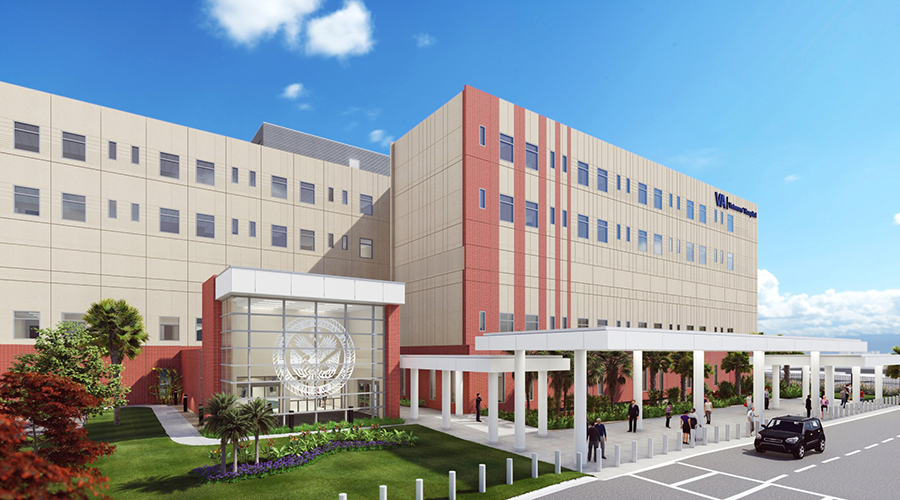Hospital bed towers are becoming increasingly popular options for healthcare organizations expanding inpatient care due to their multifunctional spaces that prioritize flexibility, comprehensive care and hospitality. To ensure the facilities deliver the intended benefits, healthcare facilities managers and organizations considering bed towers to expand their presence need to focus on several key considerations.
Robots on the rise
Robotic technology has revolutionized the healthcare industry. Robots now assist surgeons with complex surgeries and deliver supplies, and they are increasingly being used to improve efficiency and allow frontline staff to focus on direct patient care and other critical demands.
Autonomous mobile robots (AMR) equipped with vital-sign monitors can regularly check patient health parameters, alerting medical staff to emergencies. Automated guided vehicles (AGV) are material handling systems that travel autonomously through a warehouse or distribution center. They also can be used to deliver meals, return trays, transport clean and soiled linen, and deliver sterile supplies, waste bins, and carts.
In short, robots can increase system capacity and infection risk. For example, robots equipped with ultraviolet C (UV-C) technology can navigate around and sterilize an entire operating room without human intervention.
Incorporating AMRs and AGVs is a major investment, so to optimize the robots’ skills, a bed tower’s infrastructure and space should include places for them to sit and off-stage pathways.
Comfort and choice
With more choices available to healthcare consumers and staff shortages and burnout at an all-time high, hospitals are recognizing the importance of creating an environment that promotes relaxation and reduces stress for patients, staff and visitors. To achieve this, medical planners are incorporating evidence-based design, which is proven to promote healing and hasten recovery.
Healing environments allow for comfort and control. Patient rooms are designed to provide ample natural light because exposure to daylight benefits patient recovery. Customizable lighting systems and voice-activated blinds allow patients to adjust the lighting in their rooms to suit their preferences. Alexa might even be available to provide a weather forecast, stream a show on the smart television screen and find a podcast.
Indeed, patient rooms are being designed to resemble hotel rooms, offering amenities like Wi-Fi, entertainment systems, nicely appointed private bathrooms, fold-out couches and work areas, all of which keep the patient and family experience at the forefront.
With high patient volumes, noise volume also increases. State-of-the-art bed towers include noise-reduction measures, such as sound-absorbing materials, specialized ventilation systems, insulated walls and strategically locating noisy areas away from patient rooms.
Safety and mobility
Innovations in patient bed tower design also prioritize patient safety and mobility. Hospital-acquired infections (HAIs) are a significant concern. The use of antimicrobial surfaces, hands-free technology and easily cleanable materials help maintain a sterile environment.
To enhance patient mobility, bed towers are designed to accommodate the use of advanced patient-lifting systems. These systems are often installed in ceilings and allow healthcare professionals to safely move patients without the need for manual lifting, reducing the risk of injury for patients and staff. Bed towers have also incorporated wider corridors and doorways to accommodate the smoother movement of patients using wheelchairs or on stretchers.
Bedside fall prevention systems, such as bed alarms and pressure-sensitive mats, help reduce the incidence of patient falls. Enhanced fire safety measures, including smoke evacuation systems and flame-resistant materials, provide an added layer of protection.
Ceiling-mounted booms offer a streamlined approach to care delivery and are equipped with medical gas outlets, electrical connections and data ports, eliminating the need for cluttered floor-mounted equipment. They allow healthcare staff easier access to equipment and supplies, promoting efficiency and reducing trip hazards. Ceiling booms also allow for improved infection control by minimizing contact surfaces.
Efficient workflow
Innovative patient bed tower design also optimizes workflow and supports healthcare staff. Creating full-scale mockups is a helpful tactic in the schematic design phase to uncover operational inefficiencies or sticky spots.
To streamline operations, bed towers are designed with decentralized nursing stations strategically placed on each floor. This approach recognizes the relationship between nurse and patient, with a layout that allows nurses to be close to patient rooms, improves sightlines and reduces response times.
Bed towers also should feature decentralized respite areas that include such features as private cocooning spaces, breakrooms with communal tables, green roofs, terrace gardens and nearby hydration stations that provide caregivers a chance to decompress. Open, bright and relaxing areas with comfortable, stylish furniture, natural colors and greenery are instantly appealing and calming.
Digital advancements also have revolutionized patient care. Electronic medical records are integrated into bedside consoles, allowing healthcare providers to access patient information promptly. Smart technology, such as real-time locating systems, helps locate equipment and track staff members, optimizing efficiency and reducing waste.
In modern bed towers, thoughtful design makes empathetic, person-centered care the default, and patients and staff alike are more likely to feel valued, safe and supported.
Hilary Bales, AIA, EDAC, is a principal in Page’s Dallas office. Vanessa Lampe Heimbuch, AIA, LEED AP, is a principal in Page’s Atlanta office. Bales and Lampe Heimbuch have worked on inpatient bed tower projects for VA medical centers, children’s healthcare systems and academic healthcare centers.

 UF Health Hospitals Rely on Green Globes to Realize Their Full Potential
UF Health Hospitals Rely on Green Globes to Realize Their Full Potential How Healthcare Facilities Can Be Truly Disaster-Resilient
How Healthcare Facilities Can Be Truly Disaster-Resilient TriasMD Breaks Ground on DISC Surgery Center for San Fernando Valley
TriasMD Breaks Ground on DISC Surgery Center for San Fernando Valley Bigfork Valley Hospital Falls Victim to Data Breach
Bigfork Valley Hospital Falls Victim to Data Breach AI-Driven Facilities: Strategic Planning and Cost Management
AI-Driven Facilities: Strategic Planning and Cost Management